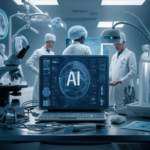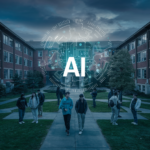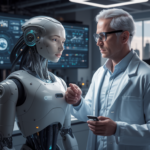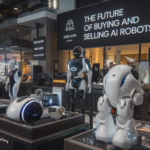Sotheby’s to Auction Its First Artwork Created by a Humanoid Robot: A New Frontier in Art and Technology
In a historic move that underscores the growing convergence of art and artificial intelligence, Sotheby’s is set to auction its first-ever artwork created by a humanoid robot. This event signals a transformative moment in the art world, where the boundaries between human creativity and machine intelligence are becoming increasingly blurred. As art aficionados, collectors, and technologists eagerly await the auction, the artwork, represents not only a milestone for AI but also a broader cultural shift in how we define art and creativity in the digital age.
The humanoid robot behind this groundbreaking creation isn’t just a sophisticated machine, but an autonomous artist capable of generating complex, thought-provoking works. With the ability to analyze vast amounts of data, understand artistic techniques, and even mimic emotional depth, this robot brings a new layer of meaning to the artistic process. Sotheby’s decision to auction this work elevates AI-generated art from experimental fringe to the heights of the traditional art market, signaling a new era where technology and human creativity intertwine.
The Rise of AI in the Art World
While the use of technology in art is not new, the introduction of artificial intelligence as a creator is a game-changer. AI-generated art has gained traction in recent years, with some pieces fetching six-figure sums at auction houses. However, this is the first time a humanoid robot—an entity designed to resemble and mimic human behavior—has produced an artwork for such a prestigious auction house. The move by Sotheby’s reflects a growing recognition that artificial intelligence is not merely a tool for artists but a force capable of producing original and valuable works in its own right.
Humanoid robots, particularly those with advanced AI capabilities, represent a step forward from previous forms of AI-generated art. These robots are equipped with sophisticated algorithms that allow them to learn, adapt, and respond to various stimuli. , the robot artist was trained on thousands of images, sculptures, and paintings spanning centuries of art history, enabling it to produce a unique work that draws from a rich tapestry of human cultural achievements.
Unlike human artists, who rely on personal experiences, emotions, and creativity, the robot operates within a framework of learned patterns and data. However, its ability to analyze and synthesize this information with surprising results raises philosophical questions: Can a robot truly be creative? Is the art it produces a reflection of the human spirit, or is it something entirely new?
The Evolution of Artistic Creation
The auction of this AI-created piece marks a significant departure from traditional artistic norms. Throughout history, art has been viewed as a deeply human endeavor, tied to personal expression, emotion, and unique perspectives. However, as AI technology advances, the definition of what constitutes “art” is expanding.
The process behind this particular artwork involved not only the humanoid robot’s programming but also collaboration between human engineers and AI specialists, who provided the robot with its foundational knowledge. This blend of human and machine input reflects the broader trend of hybrid creativity, where the line between man and machine is increasingly indistinct. The artwork is a testament to this collaboration, where human ingenuity meets artificial intelligence, resulting in a new form of expression that challenges the traditional role of the artist.
In a sense, AI and humanoid robots represent a new kind of artist, one that doesn’t experience creativity in the same way as humans but produces outputs that resonate with human audiences. The implications of this shift are profound, as it opens up new possibilities for artistic production, breaking free from the limitations of human physiology and psychology.
The Market for AI-Generated Art
Sotheby’s auction of is expected to spark intense interest from a wide range of collectors, from tech enthusiasts and AI pioneers to traditional art buyers. AI-generated art has already seen a surge in popularity, with some pieces previously sold at Christie’s and other major auction houses for hundreds of thousands of dollars. In 2018, the AI-generated painting “Portrait of Edmond de Belamy” fetched $432,500 at Christie’s, more than 40 times its initial estimate, highlighting the growing demand for this new genre of art.
However, this auction is unique, as it’s the first time a humanoid robot—not merely an AI algorithm but a physical entity resembling a human—is being recognized as the creator. This introduces a new dimension to the art market. Collectors are not just buying a piece of art; they are acquiring a part of history, a moment where the future of art begins to take shape. The sale of is expected to fetch a substantial sum, reflecting both the intrinsic value of the work and its status as a pioneering piece in the history of AI-generated art.
The Role of AI in Shaping the Future of Art
As AI-generated and robotic art continues to evolve, it will undoubtedly reshape the art world. While some critics argue that machines lack the soul, intuition, and emotional depth of human artists, others see AI as a powerful tool that can expand the boundaries of what art can be. By leveraging algorithms, data, and machine learning, AI can create works that are both novel and deeply rooted in human culture.
Moreover, as AI becomes more integrated into the art world, we may begin to see a democratization of creativity. AI tools could enable people who lack traditional artistic skills to produce high-quality art, challenging the elitism that often surrounds fine art. Humanoid robots, like the one behind , could become collaborators, assisting human artists in realizing complex visions that would be impossible to achieve alone.
What the Future Holds
Sotheby’s decision to auction this artwork represents more than just a high-profile sale. It is a bold statement about the future of creativity, technology, and the art market. As the first humanoid robot to produce a piece of art to be auctioned by one of the world’s most prestigious auction houses, this event will likely influence how future generations think about art, authorship, and the role of machines in society.
While it remains to be seen how the market will continue to embrace AI-generated works, there is no doubt that this auction is a watershed moment. It will inspire conversations about the nature of creativity, the value of machine-produced art, and the implications of allowing robots to participate in a space traditionally reserved for human ingenuity. The auction of will not just be the sale of a physical artwork but a sale of an idea—one that suggests the future of art is as much about code and algorithms as it is about paint and canvas.
In the end, Sotheby’s upcoming auction is not just a financial transaction. It’s an invitation to reimagine what art can be in the age of AI.









